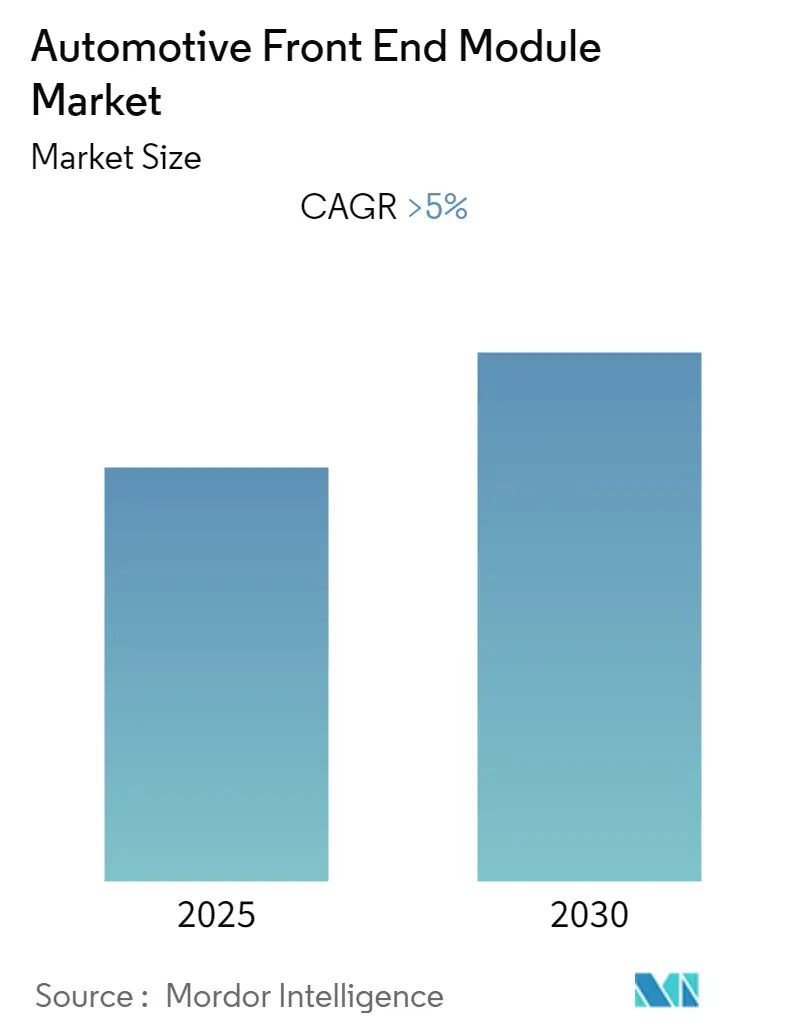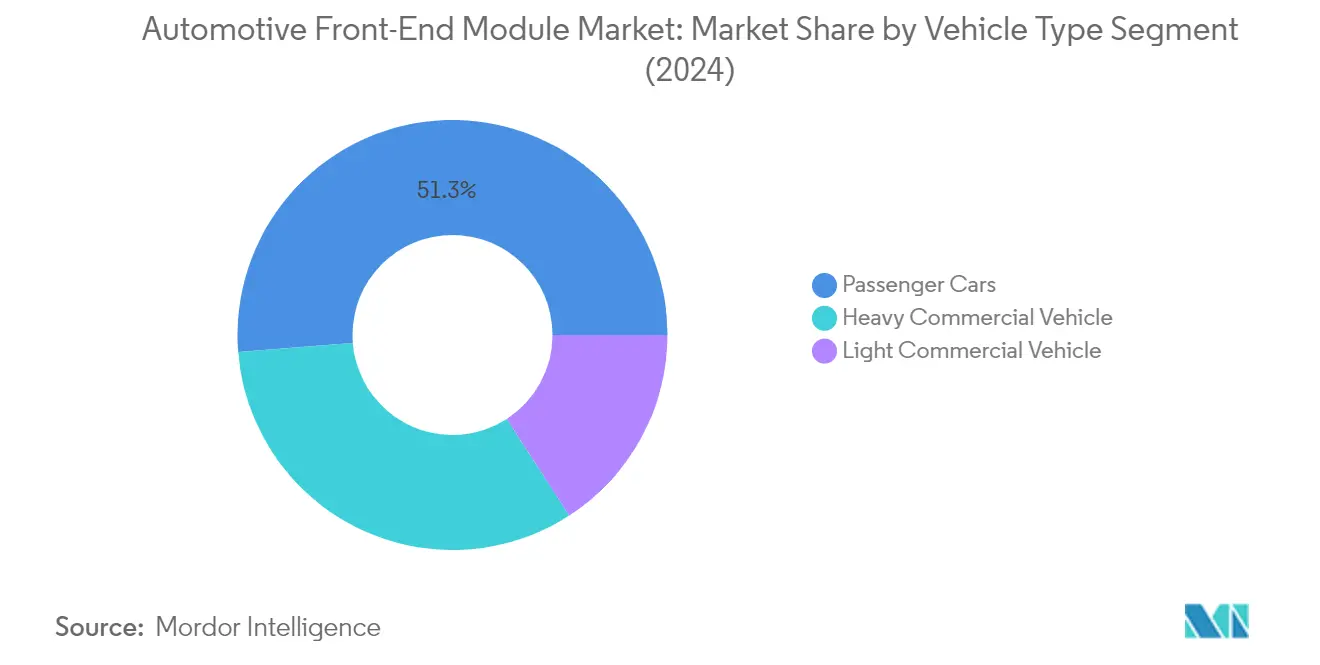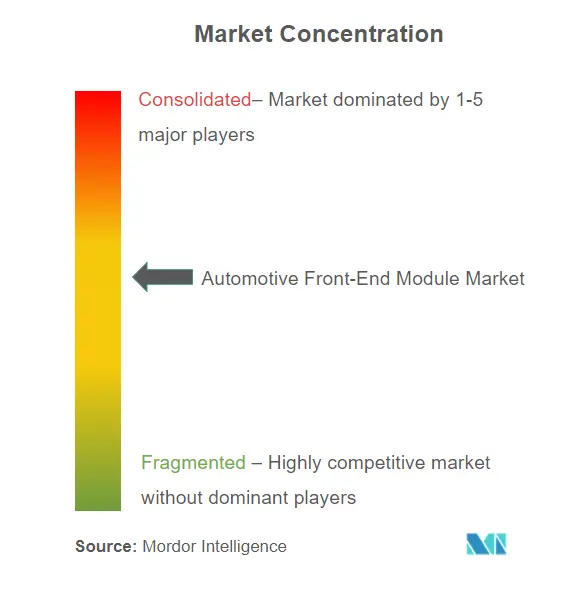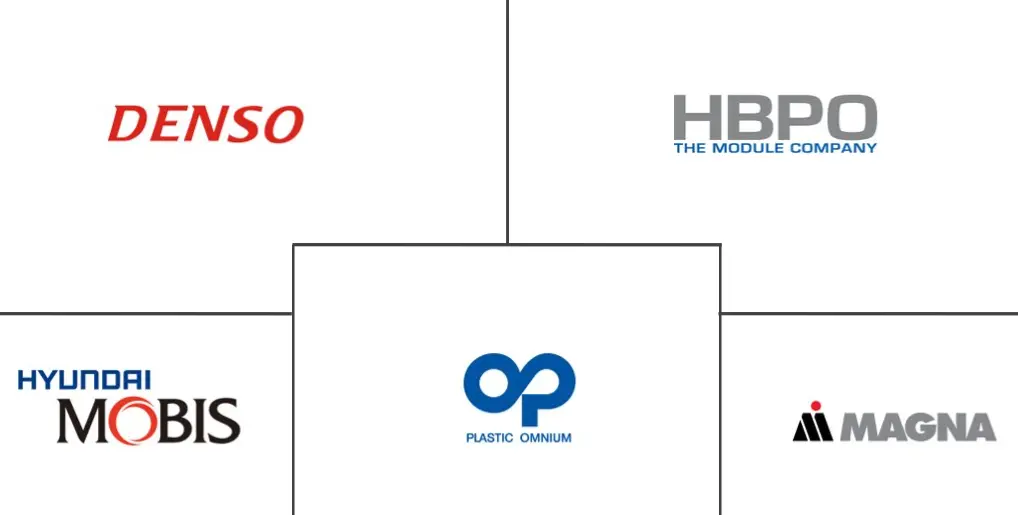Automotive Front End Module Market Size and Share

Automotive Front End Module Market Analysis by Mordor Intelligence
The Automotive Front End Module Market is expected to register a CAGR of greater than 5% during the forecast period.
The automotive front-end module industry is experiencing significant transformation driven by technological advancements and changing market dynamics. The integration of advanced sensor technologies within front-end modules has become increasingly crucial for supporting modern vehicle capabilities. This evolution is particularly evident in the electric vehicle segment, where in the United States alone, nearly 1.2 million EVs were purchased in 2023, capturing 7.6% of the total vehicle market. The industry's focus has shifted towards developing modules that can accommodate sophisticated sensor arrays, cameras, and radar systems essential for advanced driver assistance systems (ADAS) and autonomous driving features.
Manufacturers are intensifying their efforts to innovate and enhance automotive front-end module designs, particularly in response to aerodynamic requirements and efficiency demands. A notable example is Hyundai and Kia's introduction of the Active Air Skirt (AAS) technology in early 2024, which achieved a significant 2.8% improvement in drag performance during testing on the Genesis GV60 SUV. This technological advancement demonstrates the industry's commitment to developing solutions that enhance vehicle performance while maintaining structural integrity and safety standards.
The industry is witnessing substantial investments in manufacturing capabilities and research and development. In June 2023, Hyundai Mobis demonstrated this trend by announcing a USD 77 million investment in its third automotive module plant in Ulsan, South Korea. This strategic expansion reflects the growing demand for sophisticated front-end modules and the industry's commitment to enhancing production capabilities. The focus on manufacturing innovation has led to the development of more efficient production processes and the integration of advanced materials and technologies.
Production dynamics are showing strong momentum, particularly in key manufacturing regions. China's automobile production, for instance, demonstrated remarkable growth with a 29.2% surge between January and September 2023, reaching 30.16 million units. This production boost has been accompanied by significant technological advancements in automotive front-end module design and manufacturing processes. Manufacturers are increasingly adopting automated production techniques and implementing smart manufacturing practices to ensure consistent quality and meet the growing demand for sophisticated front-end modules that can accommodate various vehicle types and technological requirements.
Global Automotive Front End Module Market Trends and Insights
Increasing Emphasis on Vehicle Lightweighting is Fueling the Demand for Advanced Vehicle Front-end Modules
Vehicle lightweighting has emerged as a critical concept within the automotive sector, driven by stringent emission regulations and the growing demand for improved fuel efficiency. The integration of lightweight materials in automotive front-end parts has demonstrated the potential to reduce vehicle weight by 20-30%, significantly impacting overall performance and environmental sustainability. This transformation is particularly evident in the electric vehicle segment, where, according to recent data, the United States witnessed a substantial surge in battery electric vehicle (BEV) sales during the first quarter of 2023, with approximately 258,900 BEVs sold, reflecting an impressive year-over-year growth of about 44.9% compared to the previous year's first-quarter sales.
The industry's commitment to lightweight solutions is further demonstrated by recent technological innovations and partnerships. In August 2022, BMW Group and HBIS Group established a sustainable steel supply chain agreement, introducing low-carbon steel with a 10-30% smaller carbon footprint than conventional steel. This partnership will transition to incorporating "green steel" by 2026, utilizing the hydrogen-based DRI-EAF process, potentially reducing emissions by up to 95%. Additionally, the adoption of advanced materials like composites and lightweight metals in automotive front-end modules has enabled manufacturers to achieve superior strength-to-weight ratios while maintaining structural integrity and safety standards.
Growing Apprehension Regarding the Safety and Longevity of Vehicles is Expected to Drive the Demand for Vehicle Front-end Modules
The increasing focus on vehicle safety has led to significant technological advancements in vehicle front-end modules, which serve as the first line of defense in collision scenarios. In November 2023, Ford Motor Company demonstrated this commitment to safety by patenting innovative inflatable bumper technology specifically designed for their large SUVs and trucks. This technology, which deploys similarly to airbags upon impact detection, represents a significant advancement in pedestrian protection systems. Furthermore, front-end modules are increasingly incorporating sophisticated sensor technologies and crash energy management systems, enhancing both active and passive safety features.
Recent developments in safety-oriented design are exemplified by Skoda's April 2023 initiative to develop advanced car-to-pedestrian communication technology. The company's specially-equipped Enyaq iV model, featuring an innovative illuminating front grille, demonstrates how front-end modules are evolving to incorporate communication systems that enhance pedestrian safety. This integration of smart technologies within front-end modules reflects the industry's response to growing consumer concerns about vehicle safety, with recent surveys indicating that safety features rank as the top priority for vehicle purchases, garnering 66% preference among respondents in India during December 2023.
Shifting Consumer Preference Toward Vehicle Aesthetics Will Fuel Market Demand
The evolution of consumer preferences has placed unprecedented emphasis on vehicle aesthetics, particularly in front-end design. According to recent consumer surveys conducted in December 2023, design ranks as a significant purchase criterion, with 48% of respondents considering it a crucial factor in their vehicle selection process. This shift has prompted manufacturers to develop front-end modules that not only meet functional requirements but also contribute to distinctive vehicle styling and brand identity. The integration of advanced lighting systems, sophisticated grille designs, and seamless sensor integration has become paramount in meeting these elevated consumer expectations.
The industry's response to these aesthetic demands is evident in recent technological innovations, such as Hyundai and Kia's introduction of the Active Air Skirt (AAS) technology in April 2024. While primarily designed to enhance aerodynamic performance, this technology also contributes to the vehicle's visual appeal by creating a more sophisticated and modern front-end appearance. The technology not only improves the vehicle's drag coefficient by 2.8% but also demonstrates how manufacturers are successfully combining aesthetic appeal with functional performance, meeting the dual demands of style-conscious consumers while maintaining technical excellence. Moreover, the integration of advanced automotive cooling system technologies within these designs ensures optimal performance without compromising on style.
Segment Analysis: By Vehicle Type
Passenger Cars Segment in Automotive Front-End Module Market
The passenger cars segment continues to dominate the automotive front-end module market, commanding approximately 51% of the total market share in 2024. This dominance can be attributed to the segment's massive production volumes and the increasing integration of advanced technologies in passenger vehicles. The segment's leadership position is further strengthened by the growing emphasis on vehicle aesthetics and safety features in passenger cars, particularly in premium and luxury vehicles. Manufacturers are increasingly focusing on lightweight vehicle front-end modules for passenger cars to improve fuel efficiency and reduce emissions, while also incorporating advanced materials and innovative designs. The rising adoption of electric vehicles in the passenger car segment has also led to specialized front-end module designs that accommodate unique cooling requirements and sensor integration for advanced driver assistance systems.

Heavy Commercial Vehicle Segment in Automotive Front-End Module Market
The heavy commercial vehicle segment is emerging as the fastest-growing segment in the automotive front-end module market, with a projected growth rate of approximately 4% during the forecast period 2024-2029. This accelerated growth is primarily driven by the increasing demand for advanced front-end modules that can withstand heavy-duty applications while providing enhanced safety features. The segment's growth is further fueled by the rising adoption of electric and hybrid commercial vehicles, which require specialized front-end module designs to accommodate unique automotive cooling systems and power management components. Manufacturers are investing heavily in research and development to develop robust and durable front-end modules specifically designed for heavy commercial vehicles, incorporating advanced materials and innovative engineering solutions to meet the demanding requirements of commercial transportation.
Remaining Segments in Vehicle Type
The light commercial vehicle segment represents a significant portion of the automotive front-end module market, bridging the gap between passenger cars and heavy commercial vehicles. This segment is characterized by its unique requirements for durability and flexibility, while maintaining cost-effectiveness. Light commercial vehicles require front-end modules that can withstand regular commercial use while being lighter than those used in heavy commercial vehicles. The segment has seen increasing adoption of innovative materials and design solutions that balance performance with economic considerations, particularly in the growing e-commerce and last-mile delivery sectors where vehicle efficiency and reliability are crucial factors.
Segment Analysis: By Raw Material Type
Composite Segment in Automotive Front-End Module Market
The composite segment dominates the automotive front-end module market, commanding approximately 58% of the total market share in 2024. This significant market position is attributed to the exceptional properties of composite materials, including their superior strength-to-weight ratio, durability, and cost-effectiveness. Composite front-end modules offer manufacturers the ability to achieve substantial weight reduction while maintaining structural integrity, directly contributing to improved fuel efficiency and reduced emissions in vehicles. The segment's dominance is further reinforced by the increasing adoption of composite materials in electric vehicles, where weight optimization is crucial for maximizing range performance. Additionally, the versatility of composites in enabling complex designs and their ability to integrate multiple functionalities, such as pedestrian protection features and active grille shutters, has made them the preferred choice among automotive manufacturers.
Metal Segment in Automotive Front-End Module Market
The metal segment in the automotive front-end module market is projected to demonstrate robust growth with a CAGR of approximately 3% during the forecast period 2024-2029. This growth trajectory is driven by continuous innovations in metal manufacturing technologies, particularly in the development of high-strength, lightweight alloys that offer enhanced structural integrity and improved crash performance. The segment's expansion is further supported by advancements in metal forming processes, enabling more complex designs and better integration of safety features. Manufacturers are increasingly investing in research and development to create advanced metal front-end modules that meet stringent safety regulations while contributing to overall vehicle weight reduction objectives. The adoption of smart manufacturing techniques and automation in metal component production is also playing a crucial role in driving the segment's growth, ensuring consistent quality and improved production efficiency.
Remaining Segments in Raw Material Type
The other materials segment in the automotive front-end parts market encompasses various innovative materials such as advanced alloys and carbon fiber composites. These materials are gaining traction due to their unique properties that combine the benefits of both traditional metals and composites. The segment is characterized by continuous experimentation with new material combinations and manufacturing techniques, aimed at achieving optimal performance characteristics. While representing a smaller portion of the market, these alternative materials play a crucial role in driving innovation and providing specialized solutions for specific vehicle applications, particularly in high-performance and luxury vehicle segments. The development of these materials is closely aligned with the industry's push toward sustainable and environmentally friendly manufacturing processes.
Competitive Landscape
Top Companies in Automotive Front-End Module Market
The automotive front-end module market is characterized by intense innovation and strategic developments among key players like Compagnie Plastic Omnium SA, Magna International, Denso Corporation, and Marelli Corporation. Companies are increasingly focusing on developing lightweight materials and advanced manufacturing processes to enhance product performance and fuel efficiency. The integration of smart technologies, including sensors and ADAS capabilities, has become a crucial differentiator in product offerings. Market leaders are expanding their global footprint through strategic facility establishments and partnerships, particularly in emerging markets like India and China. There is a notable trend toward modular designs that enable customization and efficient manufacturing processes, while investments in research and development remain substantial to maintain competitive advantages. Companies are also adapting their product portfolios to accommodate the growing electric vehicle segment, developing specialized front-end modules that cater to unique EV requirements.
Consolidated Market with Strong Regional Players
The automotive front-end module market exhibits a relatively consolidated structure, dominated by global conglomerates with extensive manufacturing capabilities and established relationships with major automotive OEMs. These industry leaders leverage their technological expertise, economies of scale, and comprehensive product portfolios to maintain their market positions. Regional specialists, particularly in Asia-Pacific, are gaining prominence by focusing on specific market segments and leveraging their local manufacturing capabilities and customer relationships. The market has witnessed significant merger and acquisition activities, with companies seeking to expand their technological capabilities and geographic presence.
The competitive dynamics are shaped by long-term supplier relationships with automotive manufacturers, creating high entry barriers for new players. Companies with diverse product offerings and strong financial backing, such as Plastic Omnium and Magna International, have successfully maintained their market leadership through vertical integration and strategic acquisitions. The industry structure encourages collaboration between global players and local manufacturers, particularly in emerging markets, to leverage complementary strengths and expand market reach. Joint ventures and strategic partnerships have become common strategies for market expansion and technology sharing.
Innovation and Adaptability Drive Market Success
Success in the automotive front-end module market increasingly depends on companies' ability to innovate while maintaining cost competitiveness. Incumbent players must focus on developing advanced materials and manufacturing processes while strengthening their relationships with OEMs through early involvement in vehicle development programs. The ability to offer customized solutions while maintaining economies of scale has become crucial for maintaining market share. Companies must also demonstrate operational flexibility to adapt to changing market demands, particularly in the context of electric vehicle adoption and evolving safety regulations.
For contenders seeking to gain ground, specialization in specific technologies or market segments offers a viable path to growth. Success factors include developing innovative solutions for emerging vehicle categories, establishing strong local manufacturing presence in growth markets, and building strategic partnerships with established players. The industry's high concentration of end-users (automotive OEMs) necessitates a strong focus on quality, reliability, and long-term relationship building. While substitution risk remains relatively low due to the specialized nature of front-end modules, regulatory requirements regarding vehicle safety and emissions continue to shape product development strategies and market opportunities. Additionally, the integration of automotive cooling system technologies into front-end modules is becoming increasingly important to meet the demands of modern vehicle designs.
Automotive Front End Module Industry Leaders
-
Denso Corp
-
HBPO GMBH
-
HYUNDAI MOBIS CO. LTD
-
Magna International Inc.
-
Compagnie Plastic Omnium SA
- *Disclaimer: Major Players sorted in no particular order

Recent Industry Developments
- In July 2022, Hella GmbH & Co. KGaA (Hella), which operates under the umbrella brand FORVIA, agreed the sale of its 33.33% stake in HBPO Beteiligungsgesellschaft GmbH ('HBPO') to its co-shareholder, Plastic Omnium. The agreed purchase price amounts to EUR 290 million. The transaction is subject to customary regulatory approvals. Closing is expected in the fourth quarter of 2022. Plastic Omnium will own 100% of HBPO and will be well positioned to develop new modules and systems taking advantage of the new lighting capabilities. HBPO assembles one in five front-end modules produced worldwide.
- In January 2022, Opel announced that its new Grandland X Hybrid4 is ow a permanent all-wheel-drive vehicle offering optimal grip on slippery surfaces with high torque of the electric motors. The Opel Grandland X Hybrid4 is powered by a 1.6-liter turbo gasoline engine and two electric motors that provide the system with an overall output of 221 kW (300 hp). The power of the front electric module corresponds to 81 kW (110 hp) and that of the rear to 83 kW (113 hp).
- In October 2021, ElringKlinger AG (ElringKlinger) announced that it has developed an innovative front-end module carrier, which is used in a vehicle produced by US electric car manufacturer Lucid Motors for its first electric vehicle model Air. The front-end module support, which is manufactured in a hybrid design, can act as a support for the charge air cooler, the headlamp modules, the spray water tank, the horn, the distance radar module or the air intake.ElringKlinger manufactures the front-end module carrier using a single-shot injection molding process.
- In April 2021, Webasto unvieled a concept vehicle as a vision of the mobility of the future. The concept car brings together numerous technical solutions for autonomous driving, electrification and comfort i.e., roof sensor module with a working lidar and working camera, a large openable panorama roof, a smart lightweight front-end module, a battery and charging solution, and an integrated thermal management system.
Global Automotive Front End Module Market Report Scope
Automotive front-end modules are the type of assembly pieces that combine and involve a number of components into one. These components are forward lighting, radiators & cooling fans, grille-opening reinforcement (GOR) panels, air conditioning (A/C) condensers, crumple zones, hood latches, bumpers, and electronics & wiring.
The front-end module (FEM) is a complex assembly with very high demands on functionality, technology & fitting accuracy. The Scope of the report covers segmentation based on Vehicle Type, Raw Material and Geography.
By Vehicle Type, the market is segmented into Passenger Cars, Light Commercial Vehicles, and Heavy Commercial Vehicles. By Raw Material type, the market is segmented into Metal, Composite, and Others. By Geography, the market is segmented into North America, Europe, Asia-Pacific, and Rest of the World. For each segment, market sizing and forecast have been done on basis of value (USD billion).
| Passenger Cars |
| Light Commercial Vehicle |
| Heavy Commercial Vehicle |
| Metal |
| Composite |
| Others |
| North America | United States |
| Canada | |
| Rest of North America | |
| Europe | Germany |
| United Kingdom | |
| France | |
| Italy | |
| Rest of Europe | |
| Asia-Pacific | China |
| India | |
| Japan | |
| South Korea | |
| Rest of Asia-Pacific | |
| Rest of the World | South America |
| Middle-East and Africa |
| By Vehicle Type | Passenger Cars | |
| Light Commercial Vehicle | ||
| Heavy Commercial Vehicle | ||
| By Raw Material Type | Metal | |
| Composite | ||
| Others | ||
| By Geography | North America | United States |
| Canada | ||
| Rest of North America | ||
| Europe | Germany | |
| United Kingdom | ||
| France | ||
| Italy | ||
| Rest of Europe | ||
| Asia-Pacific | China | |
| India | ||
| Japan | ||
| South Korea | ||
| Rest of Asia-Pacific | ||
| Rest of the World | South America | |
| Middle-East and Africa | ||
Key Questions Answered in the Report
What is the current Automotive Front End Module Market size?
The Automotive Front End Module Market is projected to register a CAGR of greater than 5% during the forecast period (2025-2030)
Who are the key players in Automotive Front End Module Market?
Denso Corp, HBPO GMBH, HYUNDAI MOBIS CO. LTD, Magna International Inc. and Compagnie Plastic Omnium SA are the major companies operating in the Automotive Front End Module Market.
Which is the fastest growing region in Automotive Front End Module Market?
Asia-Pacific is estimated to grow at the highest CAGR over the forecast period (2025-2030).
Which region has the biggest share in Automotive Front End Module Market?
In 2025, the Asia Pacific accounts for the largest market share in Automotive Front End Module Market.
What years does this Automotive Front End Module Market cover?
The report covers the Automotive Front End Module Market historical market size for years: 2019, 2020, 2021, 2022, 2023 and 2024. The report also forecasts the Automotive Front End Module Market size for years: 2025, 2026, 2027, 2028, 2029 and 2030.
Page last updated on:



